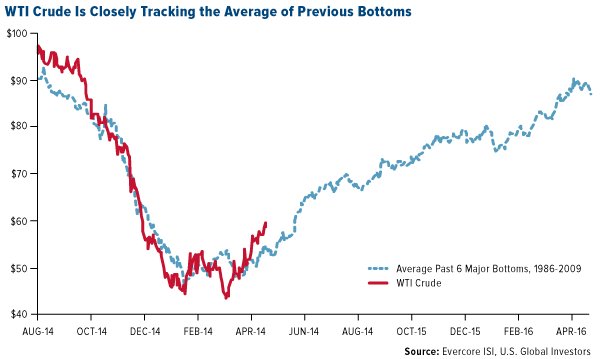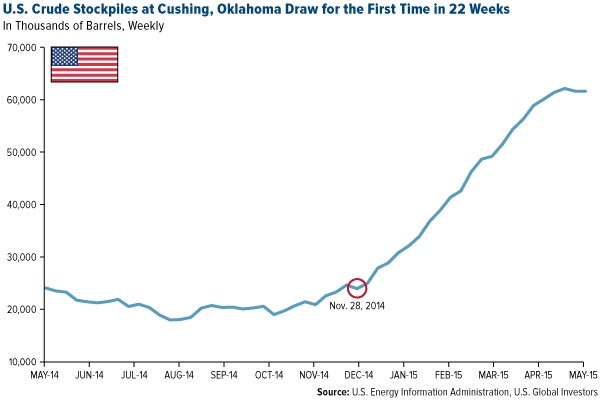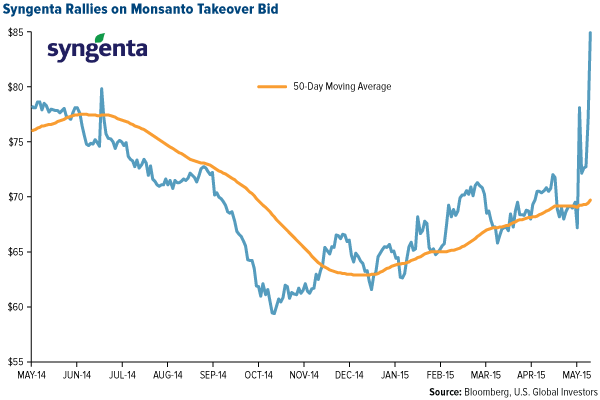The busy summer travel season is at our doorstep and with that comes stronger fuel demand.
Back in March I shared the fact that Americans drove a record 3.05 trillion miles on U.S. highways in January 2015 for the 12-month period, with even more expected this year. Now the International Air Transport Association (IATA) revealed that international passenger traffic in March rose 7 percent from the same time a year ago. Except for Africa, every region around the globe recorded year-over-year increases in air traffic.
Last week, West Texas Intermediate (WTI) crude oil prices reached a 2015 high, rising above $60 before cooling to just below that. It marked the eighth straight week of gains.
Investment banking advisory firm Evercore makes the case that the recent oil recovery is closely following the average trajectory of six previous cycles between 1986 and 2009. Although no one can predict the future with full certainty, this is indeed constructive for prices as well as the industry. 
Because oil remains in oversupply, the recent rally owes a lot to currency moves. The U.S. dollar, which has weighed heavily on commodities for around nine months, declined to its lowest point since mid-January. We might be seeing a dollar reset, which should finally give oil—not to mention gold, copper and other important commodities—much-needed breathing room.
The oil rig count continued to drop in April and is now at a five-year low. According to Baker Hughes, 976 rigs were still operating at the end of the month, down 11 percent from 1,100 in March and 47 percent from 1,835 in April 2014. Eleven closed last week alone. This spectacular plunge has had the obvious effect of curbing output and helping oil begin its recovery from a low of $44 per barrel in January. Production appears to have peaked in mid-March at 9.42 million barrels per day and is now showing signs of rolling over.
As I’ve mentioned before, price reversals have historically occurred between six and nine months following a drop in the rig count. The number of rigs operating peaked in October and oil started to bottom in January.
Even though domestic oil inventories still stand at near-record levels—according to the Department of Energy’s weekly report, they’re at their highest level for this time of year in at least 80 years—the rate at which storage facilities are being filled is beginning to slow.
For the first time since November 2014, stockpiles declined at Cushing, Oklahoma, the nation’s largest storage facility and the pricing point for WTI. 
China Continues to Stimulate Its Economy with Weak PMI Trend
Like oil, select industrial metals are making a welcome resurgence. Both zinc and copper have risen above their 50-day moving averages, with copper staging its strongest rally in about a decade. 
Besides the dollar depreciation, much of this growth derives from the hope that manufacturing in China, the world’s biggest purchaser of copper, is set to pick up. The HSBC China Manufacturing PMI fell for the second consecutive month in April to 48.9, which indicates contraction in the manufacturing sector. But global investors and commodity traders are optimistic that China’s central bank will launch a fresh round of fiscal stimulus to spur purchasing and manufacturing. I’ve observed in the past that the Asian country is quick to respond to economic indicators such as the purchasing managers’ index.
Because of its ubiquity in building construction, electronic products and transportation equipment, copper is a useful barometer of economic growth.
Several mining companies that have exposure to the red metal are performing well year-to-date. Colorado-based Newmont Mining Corporation (NYSE:NEM) is up 38 percent for the year; Australia-based Northern Star Resources Ltd (ASX:NST), 40 percent.
Agribusiness stocks have also drawn investors’ attention lately, as mergers and acquisitions (M&A) chatter has intensified. Last Friday, Syngenta AG (NYSE:SYT), the giant Swiss producer of not only seeds but also herbicides and insecticides, formally turned down a $45 billion takeover by rival Monsanto Company (NYSE:MON). As I’ve discussed before, such offers and deals have typically made the stock of the company being considered for purchase more attractive. 
In the past, ramped-up M&A activity has also suggested that a bottom has been or will soon be reached. We saw this in the oil industry, with Halliburton (NYSE:HAL) acquiring Baker Hughes (NYSE:BHI) last November and Royal Dutch Shell (NYSE:RDSa) taking over rival BG Group (OTC:BRGYY) in April.
As Yogi Berra quipped: It’s déjà vu all over again.
Disclosure: Past performance does not guarantee future results.
Foreign and emerging market investing involves special risks such as currency fluctuation and less public disclosure, as well as economic and political risk. Because the Global Resources Fund concentrates its investments in specific industries, the fund may be subject to greater risks and fluctuations than a portfolio representing a broader range of industries.
Gold, precious metals, and precious minerals funds may be susceptible to adverse economic, political or regulatory developments due to concentrating in a single theme. The prices of gold, precious metals, and precious minerals are subject to substantial price fluctuations over short periods of time and may be affected by unpredicted international monetary and political policies. We suggest investing no more than 5% to 10% of your portfolio in these sectors.
The Chinese HSBC Manufacturing PMI is a composite indicator designed to provide an overall view of activity in the manufacturing sector and acts as an leading indicator for the whole economy. When the PMI is below 50.0 this indicates that the manufacturing economy is declining and a value above 50.0 indicates an expansion of the manufacturing economy.
Fund portfolios are actively managed, and holdings may change daily. Holdings are reported as of the most recent quarter-end. Holdings in the Global Resources Fund, Gold and Precious Metals Fund and World Precious Minerals Fund as a percentage of net assets as of 3/31/2015: Baker Hughes Inc. 0.23% in Global Resources Fund; Newmont Mining Corp. 1.10% in Gold and Precious Metals Fund, 0.06% in World Precious Minerals Fund; Northern Star Resources Ltd. 5.52% in Gold and Precious Metals Fund, 0.59% in World Precious Minerals Fund; Syngenta AG 3.07% in Global Resources Fund; Monsanto Co. 3.17% in Global Resources Fund; Halliburton Company (NYSE:HAL) 0.00%; Royal Dutch Shell PLC 2.97% in Global Resources Fund; BG Group PLC 0.00%.
All opinions expressed and data provided are subject to change without notice. Some of these opinions may not be appropriate to every investor. By clicking the link(s) above, you will be directed to a third-party website(s). U.S. Global Investors does not endorse all information supplied by this/these website(s) and is not responsible for its/their content.
